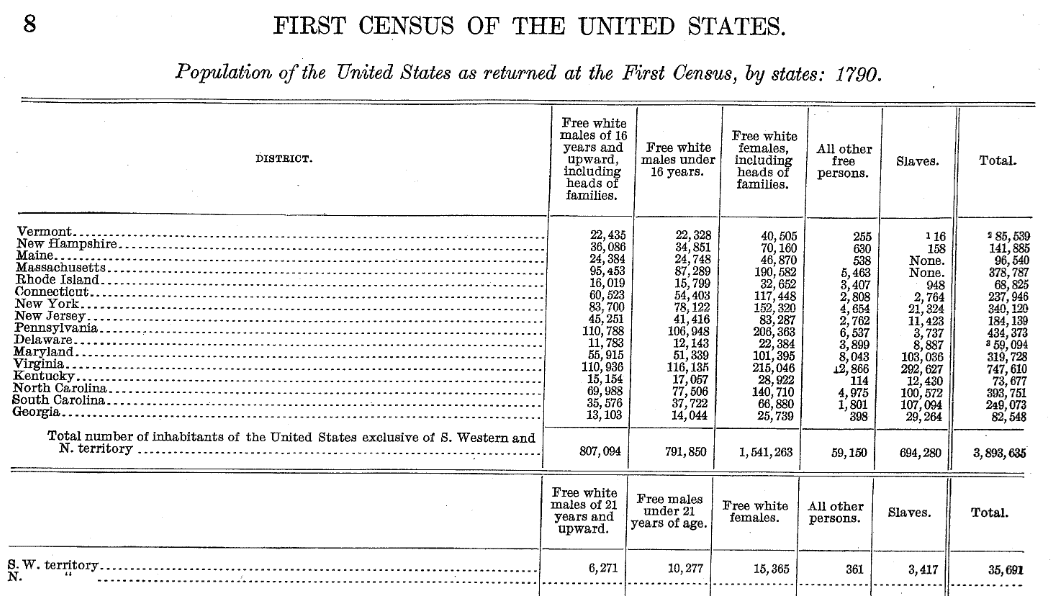After the creation of the U.S. Constitution – and shortly after George Washington’s inauguration – the United States government rolled out its first decennial census population count. The historical information from U.S. census records is vital for charting and tracking United States population and economic growth.

But what exactly went into the first census in the U.S.? When was the first census? And how, with limited technology, did they execute the task efficiently?
Read on to find out.
The First Census in U.S. History
The first decennial U.S. census was carried out in 1790. Since then, a census has been conducted every ten years, with the information being made available to the public 72 years after each census is recorded. This was in accordance with Article I, Section 2 of the United States Constitution, and the first “Census Day” took place on 2 August 1790.
Once the 1790 census was completed, the total population of America was estimated to be 3,929,214. Compared to the 327 million citizens living here today, the number is nothing short of breathtaking. We’ve certainly come a long way!
How Did They Calculate the Census in 1790?
Today, the data produced by humankind is immeasurable, unquantifiable, and purely overwhelming. The age of information and our technological renaissance has given us the ability to curate, produce, and collect data in volumes incomparable to any other time in history. But how, before the telephone and ubiquitous postal system, did they collect this data in the late 18th century?
This is definitely the appropriate time to use the adage “the old-fashioned way.” It was required – by law – that every household had to be visited, census schedules posted in two public areas of a given jurisdiction, and the census be inspected by “all concerned.” This information would then be sent to the President of the United States.
The six inquires of the first census in U.S. history asked for the individual designated as “head of the family” and any person(s) within that fell under these categories:
- Free White Males (16 years old and up)
- Free White Males (under 16 years old)
- Free White Females (no age divider)
- Any other free persons
- Slaves
Note: The reason why the “free white male” was to be separated by age was for the government to assess the United States’ current military potential.
What Were the States in the First Census?
First, there were the original 13:
- Connecticut
- Delaware
- Georgia
- Maryland
- Massachusetts
- New Hampshire
- New Jersey
- New York
- North Carolina
- Pennsylvania
- Rhode Island
- South Carolina
- Virginia
Additionally, the territories below (not yet states) were also accounted for in the first U.S. census:
- Kentucky
- Maine
- Tennessee
- Vermont
The 13 states and the 4 territories listed are what accounted for the population count of 3,929,214.
Fun fact: Both George Washington and Thomas Jefferson were extremely skeptical about the conclusion of the first U.S. census. They expected a number that was much greater than 4 million for the overall count.
Why Exactly Is the Census Important?
At its core, census data illustrates the trajectory of America. Of course, that’s a dramatic statement. But in truth, it highlights where there are gaps in infrastructure, where funds need to be distributed, and – way back when – it used to map the legislative districts and reapportion seats for Congress.
Outside of its broad-stroke impact, the census is our history. It accounts for the men and women that fought, died, and worked their entire lives building this nation. It accounts for your ancestors and their journeys through America, seeking expansion, wealth, and a better life. It highlights those that came to our land in pursuit of a dream, one that may have been the catalyst for your existence.
The census is a series of highways that form the roadmap of this nation’s bloodline.
What Can I Do with Census Data?
If you’re an experienced genealogist – or if you’re just beginning your great journey through time to discover your ancestry – then U.S. census records are an incredible tool you can utilize to learn about those that lived before you. When you use census data, the ten-year gaps allow you to chart the movement and happenings of your ancestors and, as the census progresses, more and more details will be addressed.
A Deeper Look
If your ancestors lived in America anytime between 1790 and now, then it’s likely you’ll be able to discover them, their place of birth, where they lived, what they did for a living, whom they married, how many children they had, and where they moved and died. From there, you can utilize our website to search through newspaper archives that tell the stories of your ancient relatives.
Essentially, census data points you in a direction, then we give you the shovel you need to start digging. Whether you are looking to learn more about a specific person or write your family history entirely, census records can be a great place to start. After all, it’s not just about charting the highways of your bloodline, it’s about getting to know your ancestors by discovering their stories.
Thankfully, because of the first U.S. census, this information will always be available to us. Check out other early census years including the 1800 census and 1810 census to learn more about your early ancestors. Check out other early census years including the 1800 census and 1810 census to learn more about your early ancestors.
Sources:
- United States Census Bureau. Decennial Census of Population and Housing
- United States Census Bureau. 1790 Census: Heads of Families at the First Census of the United States Taken in the Year 1790
- 13 Original U.S. Colonies – Map & Details
Related Articles:
